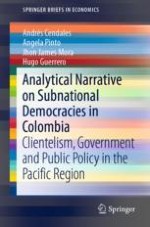
2019 | OriginalPaper | Chapter
1. Introduction. The Paradox of a Formally Open and Materially Exclusive Democracy
Authors : Andrés Cendales, Hugo Guerrero, Jaime Wilches, Angela Pinto
Published in: Analytical Narrative on Subnational Democracies in Colombia
Publisher: Springer International Publishing
Activate our intelligent search to find suitable subject content or patents.
Select sections of text to find matching patents with Artificial Intelligence. powered by
Select sections of text to find additional relevant content using AI-assisted search. powered by